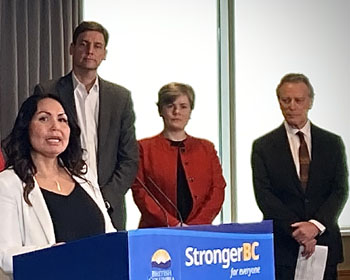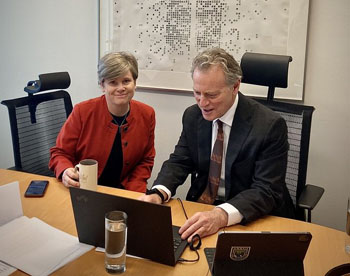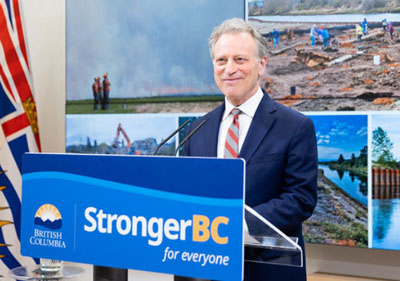
Tuesday March 14, 2023 | VICTORIA, BC
by Mary P Brooke | Island Social Trends
BC is moving forward in toward a clean energy future that is economically strong, by today launching a new Energy Action Framework. A big part of that will be electrification of industry.
As well, a B.C. environmental assessment certificate has been issued to Cedar LNG Partners LP for the proposed Cedar LNG project in northwestern British Columbia, following a joint decision by provincial ministers.
George Heyman, Minister of Environment and Climate Change Strategy, and Josie Osborne, Minister of Energy, Mines and Low Carbon Innovation, made their decision after carefully considering the environmental assessment conducted by B.C.’s Environmental Assessment Office (EAO).

Energy action framework:
There was also an announcement today about how electricity and clean economy in BC are moving forward, as part of eliminating fossil fuels. A new Clean Energy Major Projects Office is part of that, as well as a BC Hydro task force.
The New Energy Action Framework builds on actions outlined in CleanBC to drive clean economic growth, while helping the province meet its legislated climate targets.
Under the new energy action framework, the Province will:
- require all proposed LNG facilities in or entering the environmental assessment (EA) process to pass an emissions test with a credible plan to be net zero by 2030;
- put in place a regulatory emissions cap for the oil and gas industry to ensure B.C. meets its 2030 emissions-reduction target for the sector;
- establish a clean-energy and major projects office to fast track investment in clean energy and technology and create good, sustainable jobs in the transition to a cleaner economy; and
- create a BC Hydro task force to accelerate the electrification of B.C.’s economy by powering more homes, businesses and industries with renewable electricity.
The new energy action framework is “a very significant moment for climate action in British Columbia”, which supports BC’s transition to a clean energy future.
“BC won’t be left behind, we will be a leader and must act now,” said Minister of Environment and Climate Change Strategy George Heyman.

A government lead will be taken by a new Clean Energy Major Projects Office, excitedly announced by Minister Osborne today. Project oversight will include activity in green hydrogen, biofuel, renewal natural gas. Away from fossil fuels is the needed direction. “We need to do more and move faster,” said Osborne in the media session today.
The task force will look at expanding electrical energy BC Hydro, Indigenous representation and independent expertise.
Generational challenge:
The announcement about the Energy Action Framework was made today at 2:15 pm, led by Premier David Eby, saying BC is working to meet the “generational challenge of climate change”.
He talked about “responsible use of resources, protecting our kids and grand kids future”, by working with industry. “This aligns the province with efforts of industry,” said Eby today. He repeated an argument that has been heard for years now, that the economy and environment must move forward together, not at odds with each other.
“We’re moving to a future where fossil fuels are not used,” said Eby today. Electrification of the economy, using minerals more effectively, and having a regulatory process are part of the transitional process that BC is now in. Alignment with the oil and gas sector is a big part of it, he said.
“Partnerships need to be done with First Nations,” said Eby today, especially for major projects, he emphasized. He called it a “shared commitment”. Provincial and federal governments, industry and workers will be working together in all this, he outlined.
Electrification, industry:
Once BC is widely electrified — including having major industry (like LNG) plugged into the grid — Eby says it means that other jurisdictions can purchase metals and minerals that are produced to the highest social and environmental standards. He wants to see a sustainable future that is economically and environmentally sustainable for future generations.
There are currently 50 proposed projects in the hydrogen sector in B.C., representing over $7 billion in potential investment. It will also continue to monitor implementation of already approved projects to make sure they are benefiting British Columbians.

“Our commitment to British Columbians is to hit those targets, and these regulations are how we’e going to get there,” said Eby with an inspirational tone of legal authority.
BC Hydro Task Force:
- The new BC Hydro task force will ensure B.C. is well positioned to electrify B.C.’s economy and industry as the province transitions to a clean-energy future.
- It will accelerate the planning and procurement of new infrastructure needed to power B.C.’s economy with clean electricity instead of fossil fuels, while keeping rates affordable.
- It will also identify and advance Indigenous ownership opportunities in future electricity generation and transmission investments.
- The task force will include senior officials from the Province and BC Hydro, Indigenous representation and independent expertise.
Clean Energy Canada:
New directions for BC were heralded by Clean Energy Canada‘s Executive Director Merran Smith during today’s announcement.

She says Quebec is “way ahead” of BC, with already having seen millions of dollars investments in battery technology, green hydrogen, and more.
Smith highlighted the economic interaction with three US states to the south of BC: Oregon, Washington and California.
Environmental Assessment Certificate approved for Cedar LNG:
Electrified floating LNG facility at Kitimat:
George Heyman, Minister of Environment and Climate Change Strategy, and Josie Osborne, Minister of Energy, Mines and Low Carbon Innovation, made their decision to issue a BC environmental assessment certificate to Cedar LNG Partners LP for the proposed Cedar LNG project in northwestern British Columbia, following a joint decision by provincial ministers after carefully considering the environmental assessment conducted by B.C.’s Environmental Assessment Office (EAO).
Cedar LNG Partners is a Haisla majority-owned partnership with Pembina Pipeline Corporation. They proposed to build and operate the electrified floating liquefied natural gas (LNG) facility and marine export terminal in Kitimat on Haisla Nation-owned land, to be supplied with natural gas from the Coastal GasLink pipeline that is under construction. The project assessment involved extensive consultation with technical experts, federal and provincial agencies, local governments, First Nations and the public.
The ministers acknowledge that the project takes all possible measures currently available to reduce greenhouse gas emissions to the lowest feasible level. With the requirement to implement a greenhouse gas emissions reduction plan, combined with regulations that are under development by government regarding oil-and-gas-sector emissions, they concluded that the project can fit within B.C.’s climate targets and goals.
Comments from Minister of Energy, Mines and Low Carbon Innovation:
“I congratulate Haisla Nation for their vision, hard work and innovation bringing forward the Cedar LNG Project. This is an historic achievement for their community and its economic independence,” said Osborne today in a news release.
“Powered by renewable electricity and with plans to achieve near-zero emissions by 2030, Cedar LNG showcases what responsible resource development can look like as we transition to a clean-energy future,” she said.
Supports reconciliation:
The ministers also agreed that the Cedar LNG project supports reconciliation with Haisla Nation.
The ministers received letters expressing support for Haisla to pursue the project from Gitxaala Nation and Kitselas First Nation, and non-opposition to the issuance of an environmental assessment certificate from Gitga’at First Nation and Kitsumkalum First Nation.
First Nations will become equity partners in all major economic projects, said First Nations speaker Chief Sharleen Gale at today’s media session.
Cedar LNG: 16 enforceable conditions:
The ministers issued the environmental assessment certificate with 16 legally enforceable conditions that Cedar LNG must follow over the lifespan of the project. Key requirements are:
- an environmental management plan for construction to mitigate potential impacts related to air quality, waste management and accidents or malfunctions;
- a greenhouse gas reduction plan that addresses provincial emissions reduction targets and schedules, considers technologies to minimize emissions, and outlines technologies and measures to be implemented to reduce emissions;
- a community feedback process that provides residents of the area with a way to have concerns and complaints about the project resolved;
- marine transportation communication reporting with First Nations on activities that may affect marine use, and a reporting mechanism for First Nations and other mariners to report concerns;
- participation in any future regional cumulative effects initiatives related to social and economic management and monitoring, airshed monitoring and marine shipping;
- a socioeconomic management plan to prioritize regional and Indigenous hiring and procurement, provide on-the-job training and apprenticeship, and minimize impacts on local housing and accommodations; and
- a health and medical services plan to reduce pressures from an outside workforce on local health services.
Significant adverse effects unlikely:
With the scope of the requirements contained in the environmental assessment certificate, including the design features that minimize the project’s impacts on the environment, the ministers determined that significant adverse effects are unlikely to occur.
The deadline for the provincial decision was extended by 69 days to allow additional time for ministers to consider the materials and their decision.
Federal decision still required:
The project also requires a federal impact assessment and decision. The B.C. EAO carried out the assessment on behalf of the federal government under a “substitution agreement.” This means the one assessment carried out by the EAO is used to support separate decisions by each level of government, eliminating the duplication of two assessments for a single project.
The EAO recommended 65 federal mitigation measures and nine followup programs to address potential impacts from the project in areas of federal jurisdiction, including marine shipping, marine emergency response and greenhouse gas emissions. The federal decision is pending.
Cedar LNG Partners still must receive any required federal approvals and provincial permits and authorizations before they would be able to start construction.
Every project that undergoes an environmental assessment is assessed thoroughly on the specific and individual merits of that particular project.
Major project decision-making:
As part of B.C.’s environmental assessment process, First Nations, government agencies, local governments, stakeholders and the public have input on decisions about major projects.
The Cedar LNG project was assessed under the 2002 Environmental Assessment Act, for its potential environmental, economic, social, heritage and health effects.
The EAO also incorporated aspects of the 2018 Environmental Assessment Act into the assessment, including the consideration of additional assessment matters, consensus seeking with First Nations, and the opportunity for First Nations to provide a notice of consent or lack of consent at the end of the assessment process.
===== GOVERNMENT LINKS on the Cedar LNG decision:
All documentation ministers considered in making their decision is available on the EAO’s website: https://projects.eao.gov.bc.ca/p/5d64644c2f3e4f00223e81c0/certificates
Ministers’ reasons for decision: https://www.projects.eao.gov.bc.ca/api/public/document/640fadb57a7e5a0022139e32/download/Reasons%20for%20Ministers%20Decision%20-%20Cedar%20LNG%20-%2020230313.pdf
For more information about the environmental assessment process, visit: https://www2.gov.bc.ca/gov/content/environment/natural-resource-stewardship/environmental-assessments







